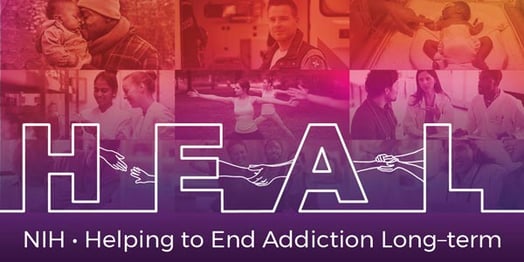CDD Wins Competitive NCATS ASPIRE Challenge #1: Databases for Discovery of Novel Treatments for Pain, Opioid Use Disorder (OUD) and Overdose

CDD wins competitive NCATS ASPIRE Challenge #1: Databases for "Discovery of Novel Treatments for Pain, Opioid Use Disorder (OUD) and Overdose" as part of the NIH HEAL Initiative
 Burlingame, California — October 3, 2019 — Collaborative Drug Discovery, provider of CDD Vault web-based drug discovery informatics platform, announced they were a winner of the NCATS ASPIRE Challenge #1: Integrated Chemistry Database for Discovery of Novel Treatments for Pain, Opioid Use Disorder (OUD) and Overdose with a proposal titled: “Integrated Preclinical, Clinical, and Post-Clinical Database”.
Burlingame, California — October 3, 2019 — Collaborative Drug Discovery, provider of CDD Vault web-based drug discovery informatics platform, announced they were a winner of the NCATS ASPIRE Challenge #1: Integrated Chemistry Database for Discovery of Novel Treatments for Pain, Opioid Use Disorder (OUD) and Overdose with a proposal titled: “Integrated Preclinical, Clinical, and Post-Clinical Database”.
The National Center for Advancing Translational Sciences (NCATS) ASPIRE Design Challenges are an important part of the NIH HEAL (Helping to End Addiction Long-term) InitiativeSM. These challenges seek to reward innovative approaches towards solving the opioid crisis and revolutionizing the discovery, development and pre-clinical testing of next-generation, safer and non-addictive analgesics to treat pain, as well as new treatments for opioid use disorder (OUD) and overdose.
The CDD proposal addresses the challenge of integrating preclinical, clinical, and post-clinical data about pain treatment and opioid use and abuse. It will provide datasets linking target and off-target information about drugs with their clinical outcomes, including adverse effects and abuse rates. The resulting database will be unique in its integrated content, standardization, and metadata about experimental and study design. The metadata will allow for better dataset generation as well as for analytics to improve assay/study design. A primary use of datasets will be to support machine methods for identifying more effective, safer, and less addictive treatments.
“It’s clear that a multi-pronged scientific approach is needed to reduce the risks of opioids, accelerate development of effective non-opioid therapies for pain and provide more flexible and effective options for treating addiction to opioids,” said NIH Director Francis S. Collins, M.D., Ph.D., who launched the initiative in early 2018. “This unprecedented investment in the NIH HEAL Initiative demonstrates the commitment to reversing this devastating crisis.”
As an advantage for this challenge, we will gather existing preclinical data within our CDD VAULT1 and BioAssayExpress (BAE)2 databases. Additional data from PubChem3, ChEMBL4, and literature will also be selected. We will leverage our metadata technology in BAE and expand it to include standards for clinical studies. Clinical study data from clinicaltrials.gov5 as well as previously curated adverse health effects and abuse data from the FDA’s Global Substance Registration System (G-SRS)6 will be added into BAE where it will be made fully integrated and accessible.
“It is an honor, a privilege, and a serious responsibility to apply our established CDD Vault platform and innovative BioAssay Express technologies for the gravest human health needs,” said CDD CEO Dr. Barry Bunin. “In addition to our long-standing commitment to neglected infectious disease, rare disease and mainstream commercial drug discovery markets, CDD is committed to helping with Opioid Use Disorder (OUD). Whether a health issue is well accepted or more taboo, the technologies can be equally helpful in minimizing human suffering and extending both the quality and quantity of life.”
References
- Collaborative Drug Discovery Inc. (CDD). (2019). Home. [online] Available at: https://www.collaborativedrug.com [Accessed 22 May 2019].
- Clark AM, Bunin BA, Litterman NK, Schürer SC, Visser U. Fast and accurate semantic annotation of bioassays exploiting a hybrid of machine learning and user confirmation. PeerJ. 2014 Aug 14;2:e524. doi: 10.7717/peerj.524. PubMed PMID: 25165633; PubMed Central PMCID: PMC4137659.
- Kim S, Chen J, Cheng T, Gindulyte A, He J, He S, Li Q, Shoemaker BA, Thiessen PA, Yu B, Zaslavsky L, Zhang J, Bolton EE. PubChem 2019 update: improved access to chemical data. Nucleic Acids Res. 2019 Jan 8;47(D1):D1102-D1109. doi: 10.1093/nar/gky1033. Epub 2018 Oct 29. PubMed PMID: 30371825; PubMed Central PMCID: PMC6324075.
- Davies M, Nowotka M, Papadatos G, Dedman N, Gaulton A, Atkinson F, Bellis L, Overington JP. ChEMBL web services: streamlining access to drug discovery data and utilities. Nucleic Acids Res. 2015 Jul 1;43(W1):W612-20. doi: 10.1093/nar/gkv352. Epub 2015 Apr 16. PubMed PMID: 25883136; PubMed Central PMCID: PMC4489243.
- Clinicaltrials.gov. (2019). Home - ClinicalTrials.gov. [online] Available at: https://clinicaltrials.gov/ [Accessed 22 May 2019].
- Tripod.nih.gov. (2019). Welcome to ginas. [online] Available at: https://tripod.nih.gov/ginas [Accessed 22 May 2019].
This content is solely the responsibility of the authors and does not necessarily represent the official views of the National Center for Advancing Translational Sciences or the National Institutes of Health.
About Collaborative Drug Discovery, Inc.
CDD’s (www.collaborativedrug.com) flagship product, “CDD Vault®”, is used to manage chemical registration, structure-activity relationships (SAR), and securely scale collaborations. CDD Vault® is a hosted database solution for secure management and sharing of biological and chemical data. It lets you intuitively organize chemical structures and biological study data, and collaborate with internal or external partners through an easy to use web interface. Available modules within CDD Vault include Activity & Registration, Visualization, Inventory, and ELN.
A complete list of more than 60 publications and patents from CDD can be found online on our resources page at https://www.collaborativedrug.com/pages/resources.


Media Contact: Barry Bunin, Ph.D., Collaborative Drug Discovery, marketing@collaborativedrug.com.


